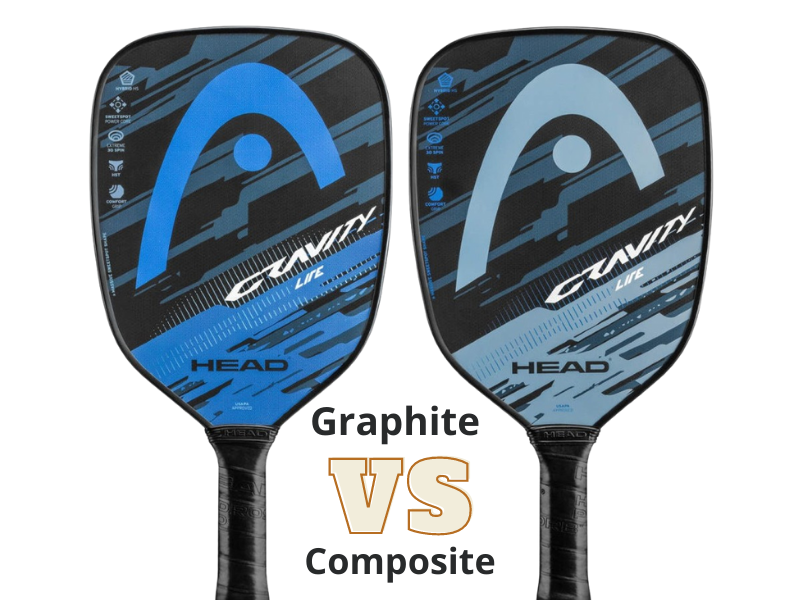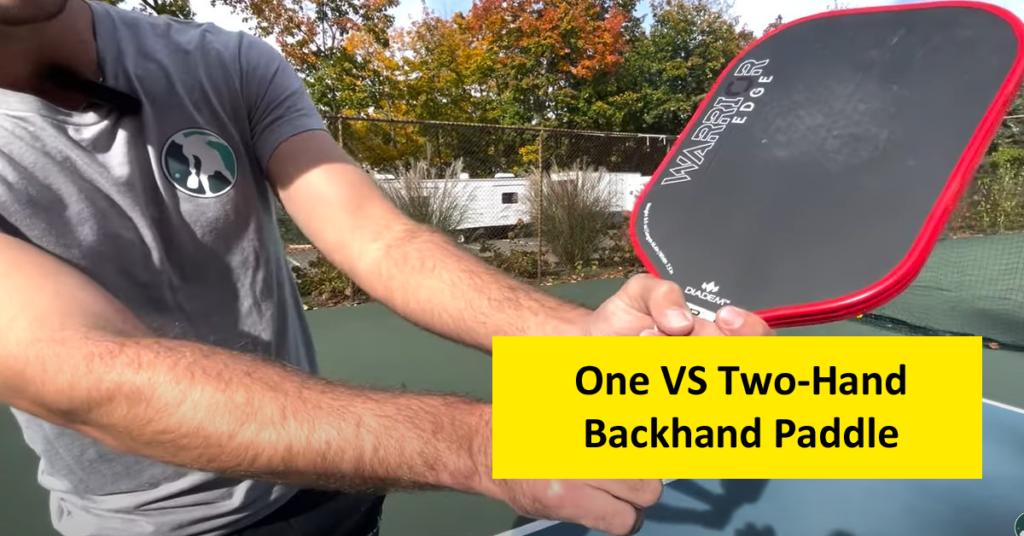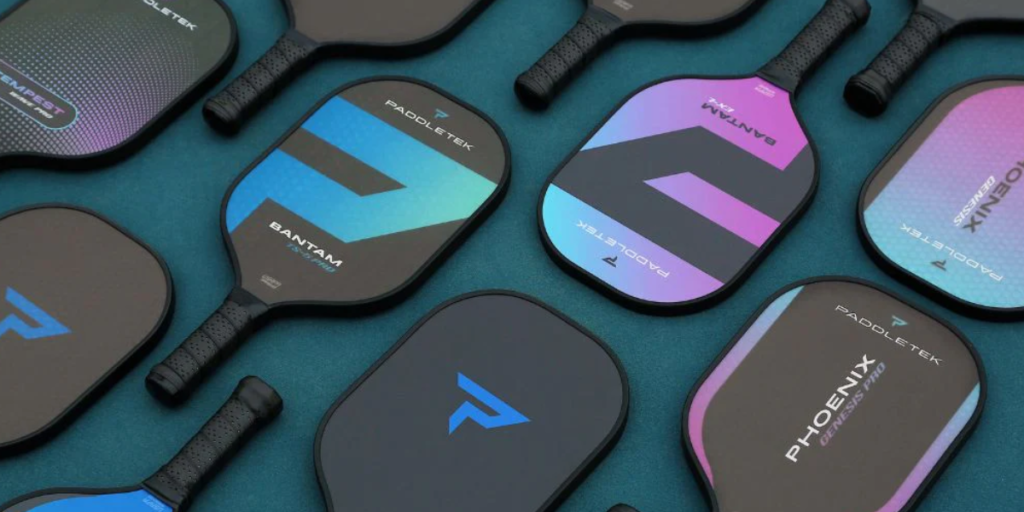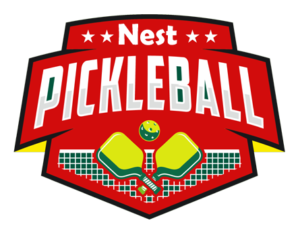There are two basic categories of pickleball paddle choices that exist today. One category is made of carbon fiber, and the other is made of fiberglass pickleball paddles.
We will go over each of these choices and how they impact the game. We will give you a detailed overview of carbon fiber vs fiberglass pickleball paddles in each aspect so that you will understand better which one is the best for you.
What is Fiberglass?
In case you didn’t know, fiberglass is a composite material composed of small glass fibers embedded in a binder. It is a strong, durable, fire-resistant, and lightweight material used to construct boats, cars, and other products.
In order to produce fiberglass, molten glass is poured into molds and allowed to cool and harden. Once hard, the glass is cut into long thin pieces called strands and wound onto a reel. From there, the fiberglass is processed into the final shape desired.
What is Carbon Fiber?
Carbon fiber is a popular choice in the material world for aircraft and automobile parts. It is the strongest of its kind. It is stronger than aluminum, steel, and titanium and even stronger than the natural fibers found in wood. Carbon fibers are also extremely light.
A material made of one hundred percent carbon fibers weighs one-third as much as steel and aluminum. However, it is used to construct everything from the wing tips of the fastest airliners to the floor of the Sistine Chapel. It is a strong, lightweight material made from carbon atoms. Carbon fiber is strong and flexible. It is one of the most versatile materials in the aerospace industry.
Comparison of Carbon Fiber VS Fiberglass Pickleball Paddles
The key differences between Carbon Fiber and Fiberglass Pickleball Paddles boil down to their distinct attributes in weight, power, control, durability, price, and tactile feedback.
Carbon Fiber paddles are lighter, enhancing agility, and offer more power due to their stiffness, yet this can sometimes compromise control on softer shots. They are also more durable and typically have a higher price point.
On the other hand, Fiberglass paddles are slightly heavier, which can contribute to more power, but they excel in control, allowing for precision and finesse. They tend to be less durable than carbon fiber paddles but are more cost-effective and provide a flexible feel on impact, giving players better feedback when striking the ball.
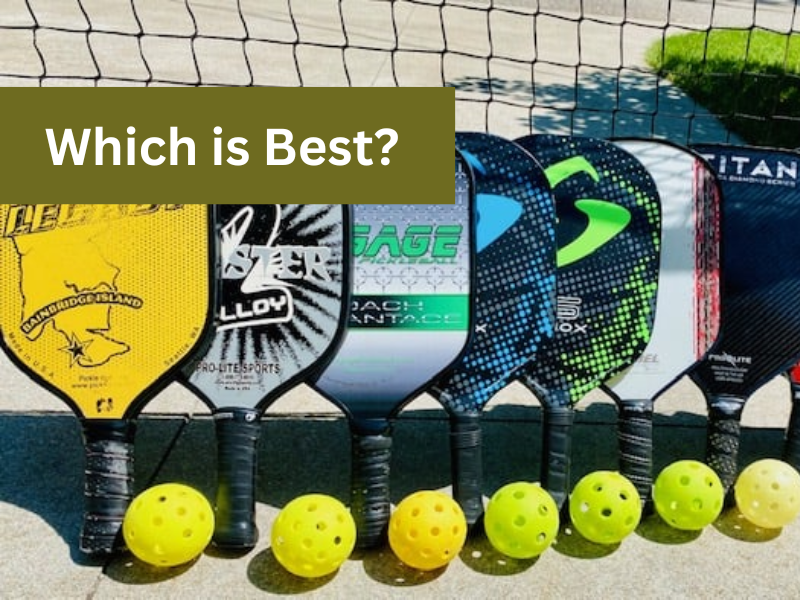
However, for more comparison and key features, here are the differences between carbon fiber and fiberglass paddles.
Fiberglass Pickleball Paddles
Fiberglass is a great choice for a pickleball player. Because of the weight and maneuverability of a fiberglass pick, a player can hit the ball much more aggressively and efficiently.
These paddles are a bit heavier than wood ones. However, they can easily balance to reduce the weight of the paddle. In addition, fiberglass paddles are extremely durable. They can be used on and off the court with little to no damage. Fiberglass paddles are a bit less expensive than wood paddles.
The only problem with fiberglass paddles is the amount of racket needed to balance them. Fiberglass paddles require a wider racket.
- Weight: Fiberglass paddles are also lightweight but may be slightly heavier than carbon fiber, providing a bit more heft behind the ball.
- Power: These paddles offer a good balance of power and control but may not provide the same level of force as carbon fiber.
- Control: The flexibility of fiberglass allows for better control, particularly in the finesse aspect of the game.
- Durability: While durable, fiberglass paddles may show wear more quickly than their carbon fiber counterparts.
- Price: Fiberglass paddles are generally more budget-friendly, making them accessible to a broader range of players.
- Feel: They have a more flexible feel on contact, which can offer more feedback and touch.
Carbon Fiber Pickleball Paddles
Carbon fiber is the most expensive type of paddle. Its advantage is that it is lighter and stronger than the fiberglass paddle. So, a carbon fiber paddle is called a lightweight one. However, these materials are carbon and graphite fibers.
There is a huge variety of paddles of this type, and one cannot find a single paddle of this type that is the best. Some of the paddles can withstand extreme pressure and provide the maximum grip, but the main thing is that they are very expensive.
- Weight: Carbon fiber paddles are typically lighter, allowing for quick hand movements and agility.
- Power: Due to the stiffness of carbon fiber, these paddles can generate more power, making them a favorite for players who like to hit hard.
- Control: While they offer more power, the rigidity can sometimes reduce control, especially for soft shots like dinks.
- Durability: Carbon fiber is known for its longevity and resistance to wear, offering players a long-lasting paddle option.
- Price: The high-quality material of carbon fiber usually comes with a higher price tag.
- Feel: They provide a firm, solid feel on contact with the ball, which some players prefer for consistent striking.
Pros and Cons of Carbon Fiber vs Fiberglass Paddles
| Paddle Type | PROS | CONS |
| Carbon Fiber | Extremely lightweight Strong Best for intermediate Effective performance | Fragile Pricey |
| Fiberglass | Affordable Durable Best for beginners Flexible | Heavy Less rigid |
Common Key Feature Comparison Between Fiberglass and Carbon Fiber Pickleball Paddles
Fiberglass and carbon fiber paddles are popular choices in paddle tennis due to their lightweight nature and superior rebound capabilities. The primary distinction between these two materials lies in their manufacturing process and resultant performance characteristics.
However, the carbon fiber paddles improve your game, while the fiberglass helps you to stable your game.
Manufacturing Process
Carbon fiber is more expensive because it has to be hand-crafted in a mold and requires a lot of labor. The result is superior paddles that are lighter and more durable than fiberglass paddles.
Fiberglass, on the other hand, is molded by a machine and doesn’t require any manual labor, so it’s the cheapest option for a paddle. But since it’s molded, it has a much rougher surface, which makes it less forgiving. This makes fiberglass paddles great for recreational paddlers. It is not recommended for serious competition.
Durability
You can’t beat fiberglass paddles for durability. They won’t warp or twist and last longer than other materials. Fiberglass paddles are often considered superior to carbon fiber, but both materials offer great benefits.
Stronger & Lighter Paddle
Carbon fiber is much stronger and lighter than fiberglass and is more responsive, but it is more expensive. While carbon fiber paddles aren’t as durable as fiberglass paddles, they are less prone to breakage and easier to repair.
What is the Best Carbon Fiber Paddle?
The CRBN Pickleball Paddle is the right choice for me because it worked well for my needs, but many other options are available. Check out the video below for a side-by-side comparison between the Fiberglass and Carbon Fiber Pickleball Paddle to help you determine which is right.
How Do You Clean Fiberglass Pickleball Paddles?
Fiberglass paddles are made of fiberglass. They should regularly clean to avoid mold growth. They will last a lifetime if they are clean and free of fungus.
If you use a fiberglass paddle and it gets dirty, soak it for 5 minutes in water and then allow it to air dry. This will take out the dirt, and the water will eventually dry out the fibers, making them brittle. You can replace the paddle when this happens.
How Do You Clean a Carbon Pickleball Paddle?
I am sure there is an even more effective way of doing it than this, but this is my method.
Well, cleaning a carbon pickleball paddle is a simple process to ensure its longevity and performance. Start by gently wiping the paddle’s surface with a soft, damp cloth to remove any dirt or grime. If necessary, use a mild soap solution, but avoid harsh chemicals that can damage the carbon fiber. For stubborn spots, a soft-bristled toothbrush can help lift dirt without scratching the surface.
After cleaning, dry the paddle thoroughly with a towel before storing it. Regular maintenance like this will keep your carbon pickleball paddle in top condition for your games.
Conclusion
In this article, I have told you the differences between fiberglass and carbon fiber pickleball paddles. Carbon fiber is the best choice if you want a better grip and less pressure on your hands and shoulders.
However, if you’re seeking the affordability of a fiberglass paddle with the benefits of carbon fiber, consider opting for a wooden paddle. With this choice, you can acquire a high-quality paddle suitable for your gameplay without stretching your budget.
FAQs – Carbon Fiber VS Fiberglass Pickleball Paddle
How long do fiberglass pickleball paddles last?
Most paddles will last between 1-5 years, depending on use and how well it is cared for.
Are carbon fiber paddles worth it?
Carbon fiber paddles are great for the long term. It is lightweight, easy to maintain, and lasts a lifetime.
Are fiberglass paddles better?
A paddle made with fiberglass is often more expensive than aluminum/plastic but more affordable than carbon fiber.
Do carbon fiber paddles break?
Carbon fiber paddles are not likely to crack or splinter like fiberglass paddles. They are stronger than steel paddles and more durable than titanium.


